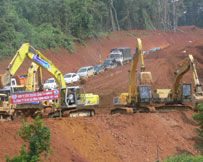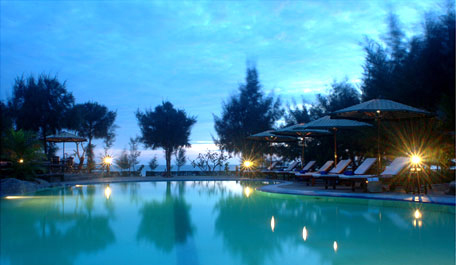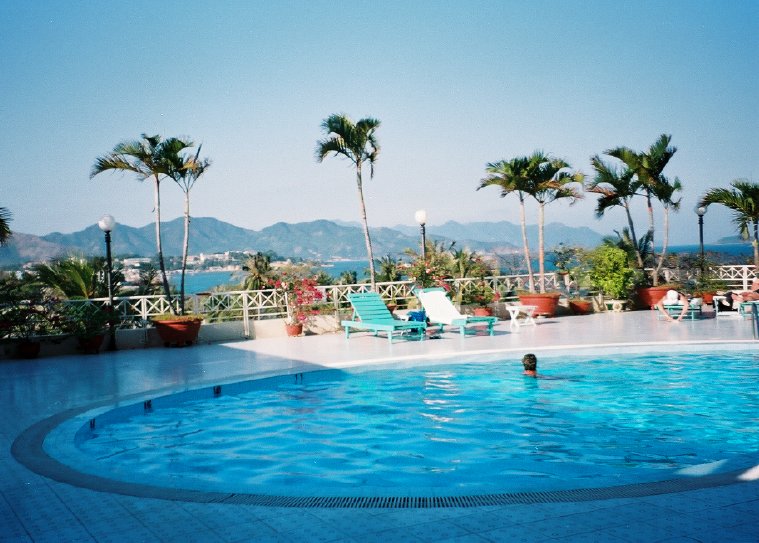INDOCHINA INTERNATIONAL CONSULTING CO., LTD
HO Add: 62L/36 Nguyên Hồng, Ward 11, Bình Thạnh District, HCMC - Vietnam
Biz Office Add: #48 Road No 11, Quarter 6, Hiệp Binh Chánh Ward, Thủ Đức, HCMC - Vietnam
®Source: http://viipip.com should be clearly quoted for any use of information extracted from our website.
Publication permit No: 60/GP-TTĐT , April 05, 2010.

Dammed and damned
Date: 11/10/2009 10:39:10 AM
Vast areas of forests are being sacrificed in the central region and the Central Highlands to build hundreds of hydropower plants, and experts are warning of serious environmental and social consequences.

The groundbreaking ceremony for the Thuong Kon Tum Hydropower Plant project in Kon Tum Province.
A total of 60 large-scale hydropower plants of between 54 megawatts and 2,400 megawatts capacity will be constructed on central rivers by 2020. This is not including hundreds of smaller plants in central provinces, including 80 in Kon Tum, 57 in Quang Nam and 64 in Dak Nong.
“Besides vast areas of protective forest being chopped down, the Tra Xom power plant project has swallowed nearly 80 percent of the commune’s rice area and hundreds of hectares of other crops,” said Dinh Drin, chairman of Vinh Son Commune People’s Committee in Binh Dinh Province’s Vinh Thanh District.
Many officials are concerned about an even more serious threat, severe environmental impacts on the region as a whole.
Bui Cach Tuyen, head of the Environment Department under the Ministry of Natural Resources and Environment, said dams would obstruct the natural flow of rivers and affect local flora and fauna. “I have never come across an aggregate report on possible impacts to river systems from collecting water in reservoirs to generate power,” he said.
Hoang Van Bay, deputy head of the ministry’s Water Resource Management Department, said people in the central region could suffer serious droughts and floods because of the power plants. “A series of hydropower plants will be constructed on each river but there has been no assessment of possible impacts,” he said.
“The investors have focused on the electricity to be generated without paying attention to regulating water flow in the river. This has worsened the threat of dangerous floods in rainy seasons and drought in dry seasons in the lowlands,” he added.
|
POWER PLANTS
in the central region and Central Highlands Quang Nam Province: 62 licensed projects
Thua Thien-Hue Province: 11 projects on the Huong River and other 12 small-sized plants
Binh Dinh Province: 7 licensed projects and 20 others were submitted by the end of 2008.
Gia Lai Province: 7 major plants and 113 small-and-medium sized projects, including 21 in operation.
Dak Nong Province: 3 plants under construction and 70 small and medium sized, with 26 in operation.
|
The US Energy Information Administration has reported up to 20 percent of Vietnam’s domestic energy consumption comes from hydropower, the highest in Southeast Asia. With the fast-track growth that the country is set on, the hunger for power is unlikely to be satiated any time soon.
Deeper destruction
“Most hydropower plant projects are located in major protective forests and projects invested in later often destroy more forests than the earlier ones because they are located deeper,” said Huynh Thi Thanh Thuy, deputy director of the Phu Yen Province’s Department of Planning and Investment.
More than 630 hectares of forest in Binh Dinh Province’s Vinh Thanh District have been chopped down for the construction of the Tra Xom hydropower plant alone. Up to 11 large-scale power plants in the district are being built or have been approved.
Another 1,100 hectares of forest in Binh Dinh will be destroyed for other projects, including Vinh Son 2, Vinh Son 3, Vinh Son 4, Vinh Son 5 and Nuoc Luong.
In Quang Nam Province, up to ten large-scale power plants will be constructed on the Vu Gia, Thu Bon rivers besides dozens of other small-and-medium sized projects in the survey stage.
Duong Chi Cong, director of Quang Nam Department of Natural Resources and Environment, said up to 4,000 hectares of forest had been cleared for the construction of four power plant projects, excluding 6,000 hectares being chopped down to construct the electric lines. “It is unimaginable [the consequences] if Quang Nam completes construction of all approved hydropower plant projects,” he said.
Early this month, a serious flood in Quang Nam triggered by the typhoon Ketsana that hit the region on September 29 swept huge amounts of chopped logs downstream the Vu Gia River. People have said they had been cut for the construction of power plants rather than by illegal loggers.
The construction of Dak Ru Power Plant in the Central Highlands province of Dak Nong has also devastated hundreds of hectares of forest although it could only generate 7.5 megawatts of power.
Social catastrophe
More than 6,000 residents will have to be displaced for constructing the Plei Krong hydropower plant project in Kon Tum Province, the reservoir for which will occupy more than 4,000 hectares of land.
A recent survey reported residents of the province’s Sa Thay, Dak Ha and Dak To districts have suffered seriously from the project, including many families having to give up four hectares of coffee gardens each.
Nguyen Van Doi, deputy chairman of Hong Thuong Commune in Thua Thien-Hue Province’s A Luoi District also criticized the social consequences of hydropower plants. “The number of poor families has increased from 80 to 167 after a power project was constructed,” he said.
Local media have repeatedly reported on how residents displaced by power plant construction have to struggle to adapt with sloppily constructed resettlement areas while they no longer have any land for cultivation.
Signs of things to come
Late September, the A Vuong power plant in Quang Nam Province allegedly released water without warning, worsening flooding caused by typhoon Ketsana, making it impossible for the province to take timely mitigation measures and provide relief.
Nguyen Thanh Quang, vice director of Quang Nam Department of Agriculture and Rural Development, slammed the plant operator, A Vuong Hydroelectric Joint-stock Company, saying the discharge of nearly 150 million cubic meters of water while downstream water levels were increasing submerged many villages in Dai Loc District. The floods then rose higher than those of previous years by nearly 1.5 meters, he added.
Le Minh Anh, chairman of Quang Nam People’s Committee, said the locality has learnt the hard way the consequences of hydropower plant construction through recent flooding, including the A Vuong incident. He said committee would tighten the planning and construction of the plants as well as investor’s commitment to plant forests to replace areas they had cut down.
“Investors failing to keep their commitment will be fined the money needed to replant the forest,” he said. However, Anh admitted no investor has so far kept the promise to replant forests, nor has any action been taken against them.
|
IN THE BREACH
Ta Van Huong, head of the Energy Department under the Ministry of Industry and Trade, admitted that a drastic increase of hydropower plants has affected the environment.
However, he said it was the provincial administrations that were responsible for assessing and approving small-and-medium sized plants as stipulated in a governmental decree.
“Many enterprises have invested in hydropower plant projects because it can bring in good profit,” he said, adding plants of less than 1 MW capacity have been built.
He also said the government has issued strict procedures for planning and building dams including the need for environmental impact assessments, because the reservoirs in these projects would use forest land and force the resettlement of residents.
But some localities have breached the regulations and gone ahead with the projects without going through the needed preparatory steps, he added.
|
(Source:Thanh Nien + Agencies)
- FDI capital continues to pour into Vietnam (6/11/2025 1:20:33 PM)
- Thanh Hoa receives good news: Preparing to have an additional industrial park of up to 470 hectares, creating jobs for nearly 30,000 people (6/11/2025 1:15:09 PM)
- Industrial Park Real Estate: Waiting for the New Generation of FDI (6/11/2025 1:10:15 PM)
- A wealthy Vietnamese city will have two special economic zones after the merger (6/11/2025 1:04:42 PM)
- 30 billion USD capital FDI in Việt Nam by 2025, a series of "ông big" races to expand the land fund (6/11/2025 12:55:26 PM)
- the 2nd largest city in the North will start construction on an international economic zone (6/11/2025 12:50:20 PM)
- Japanese giant Sumitomo continues to want to build an industrial park in the countrys fourth smallest province. (6/11/2025 12:40:45 PM)
- 3 foreign corporations want to invest billions of dollars in Ba Ria - Vung Tau (6/11/2025 12:34:30 PM)
- Lotte Group member starts construction of nearly 1,000 billion VND logistics center in the province with the most industrial parks in Vietnam (6/11/2025 12:33:26 PM)
- Forming a regional center for manufacturing spare parts and components (6/11/2025 12:24:08 PM)
- Vietnams first wafer factory is about to start construction (6/11/2025 12:19:09 PM)
- Dong Nai attracts foreign investors (6/11/2025 12:13:27 PM)
- Tay Ninhs largest industrial park welcomes a $150 million high-end knitted fabric factory project (6/11/2025 12:11:00 PM)
- (6/11/2025 12:09:10 PM)
- Vietnam will become a destination for Chinese investors in the future (11/6/2023 1:03:19 PM)

- FDI capital continues to pour into Vietnam
- Thanh Hoa receives good news: Preparing to have an additional industrial park of up to 470 hectares, creating jobs for nearly 30,000 people
- Industrial Park Real Estate: Waiting for the New Generation of FDI
- A wealthy Vietnamese city will have two special economic zones after the merger
- 30 billion USD capital FDI in Việt Nam by 2025, a series of "ông big" races to expand the land fund










 ADB: Vietnam’s 2009 GDP growth to be highest in South East Asia
ADB: Vietnam’s 2009 GDP growth to be highest in South East Asia MGM Grand Ho Tram: Vietnam’s First ‘Las Vegas Style’ Integrated Resort
MGM Grand Ho Tram: Vietnam’s First ‘Las Vegas Style’ Integrated Resort Nha Trang’s Twin Towers project licenced
Nha Trang’s Twin Towers project licenced Foreign investors still have good opportunities in Vietnam
Foreign investors still have good opportunities in Vietnam Sierra Wireless gets a foot in Vietnam’s ICT market
Sierra Wireless gets a foot in Vietnam’s ICT market